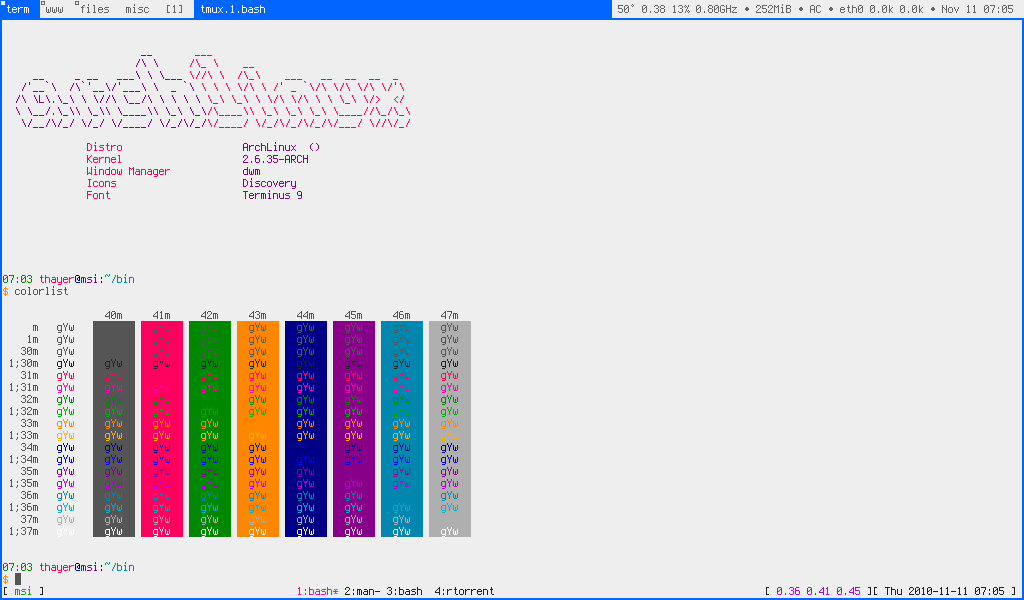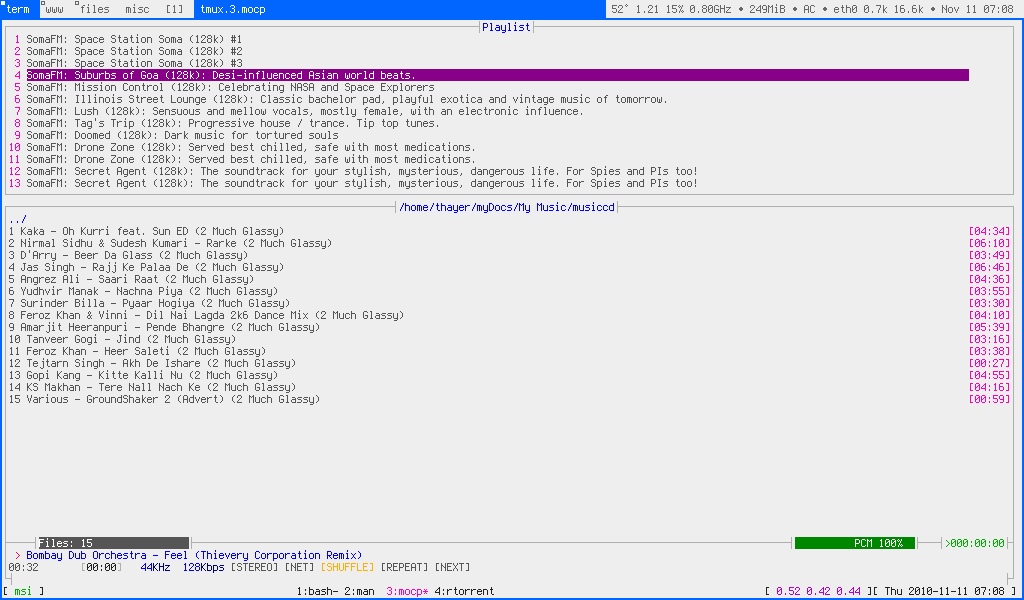I had an Aspire One D270 laptop with a 32-bit Intel Atom CPU and 1 gigabyte of RAM, so I installed Debian with Xfce on it, but even then it’s running way too slow.
Is there anything I can do to make the laptop faster and more responsive given its limited memory?
You need something like DamnSmallLinux, not Debian. Debian users about 800 MB of RAM with XFce, on a clean boot. It requires a minimum of 2 GB with a modern browser (one tab, 4+ GB with more tabs). DamnSmallLinux uses about 128 MB RAM on a clean boot, and with the Netfront browser about half a gig. Definitely better for such a laptop than any modern distro.
Antix linux would also work great, and DSL is based on it.
Maybe try Openbox instead of XFCE. Can’t promise it’ll add much memory but with 1gb RAM I guess every bit counts?
Edit: just had a quick look around, and it looks like your machine can be upgraded to a whopping 2gb RAM… It’s still not great, but it is a 100% increase in memory.
Edit 2: I’m not actually recommending you buy RAM from memorystock.com, it just turned up at the top of my search results. The page should give you the type and version you’ll need to look for, though.
2 gb memory should make XFCE usable. That’s what my crappy laptop has and XFCE works fine. I use Firefox with a few open tabs and watch YouTube at 720p.
I once swapped a Debian install with XFCE to just running Openbox instead of a full DE and got down to 300Mb or so of memory usage. This was about a decade ago so obviously YMMV but given literally all I did was run Debian with just openbox and no DE, there’s probably additional tuning to be done that can get them to a more usable state
SSD upgrade
And then ZRAM and swap like hell
I thought it’s either swap or ZRAM - could you use both at the same time?
Yes Fedora uses swap and zram by default. Just compresses the memory in RAM (more memory available) and on disk (less data written, less wear)
Wow, that’s supercool actually! I had no idea…
Won’t that kill the SSD on short notice? Or can they make do with it for years?
I mean, worth the tradeoff? Zram would just make the cpu work more. Swap… kill the ssd
But over time. SSDs can handle a lot, like a couple of years?
Won’t be a couple of years if you’re constantly swapping, no.
Not really, if you would spend a lot more on SDD drives instead of getting a modern computer
Do you have numbers? I dont think its that dramatic
deleted by creator
This will be the single biggest change you can make. Swapping an hdd for a cheap 256gb ssd will make a bigger difference than any DE changes.
If you use mechanical hard drive in it, it worth a try to replace it with an SSD. After that, Debian should run much better.
Hopefully it got standard SATA connector.
You can buy IDE m.2 converter. There are usb to floppy converters, usb drive shows up as floppy drive. You can attach modern peripherals to old computers, this kind of retro world with modern and old parts mixed is funny.
Would it worth, though? I mean, is there a significant difference on IDE between HDD or SSD? With an adapter, SATA speeds on the long run would be bottlenecked by IDE if I’m correct.
Still worth it, for the latency elimination alone. But also I expect a SSD would saturate the IDE connection whereas a HDD rarely would.
I can speak from experience that it is worth it. It won’t be a super speed demon, but it will make it somewhat more usable. I’ve done so with my Asus Eee PC 901 netbook which has the two PATA SSDs. Those SSDs are SUPER slow compared to the cheapest mSATA SSD you can find with more than double the space, and all you need is a MiniPCI-to-mSATA adapter (the Eee PC 901’s drive slots are MiniPCI). I documented all about it here: https://claudiomiranda.wordpress.com/2020/10/04/my-geeeky-experiment-part-3/
I’m running OpenBSD/i386 on mine which isn’t as fast as something like Linux, but it definitely felt faster even with OpenBSD after the hardware upgrade. I also increased the RAM to 2 GB which is the maximum amount supported.
Yeah, it’s not quick, there is no noticeable difference in speed. Random read should be much quicker. But you can’t really buy ide hdds anymore and they will die sooner or later, and the price of small m.2 sata ssds are falling.
without any checking of course, I assumed that machine is “new enough” to have some form of SATA in it, but good point
Yeah the machine is 32-bit, so it’s a question worth asking.
Time flies, where a HDD is barely enough to run a minimal Linux.
I acquired an ewaste laptop with an 8 year old celeron, 4GB of memory and a 500GB HDD. I tossed Linux Mint on there as an experiment to see what would work decently on there. Its not great, but its usable and might become my daughter’s first computer. Running firefox its noticably slow but I can crack open Libre Office or ScummVM and other than the initial load time it’s pretty snappy. I kinda forgot how hard drives give systems that slow-then-fast feeling…
JWM is my suggestion. It’s a floating window manager (not tiling) that doesn’t require almost any knowledge or key bindings to use and it has all necessary stuff included out of the box afaik. You can also use xdgmenumaker to make the right click/Start menu better.
Try puppy linux ?
It’s a bit on the complicated side but still a good distro.
either you go the easy route and use a distribution targeted towards low spec systems like damn small linux or you go the difficult route and implement the same measures that they implement onto your debian installation.
last time i was in your situation i ended up doing both and i’m glad i did because my version of the build never worked as well as the custom distro.
could always give antix linux a shot
Someone suggested antix. I second that. Try it. They got 32 bit version.
It seems like you’ve got plenty of choices already, but how about an OS that’s already been cut down to work on the limited RAM of a Raspberry PI? It bills itself as a good alternative for limited hardware.
If that’s one of those old 10" netbooks, I had good experiences running dwm and xmonad on mine back in the day (had an Acer and later an MSI Wind U120(?)). Typically ran all my apps maximized, one per desktop. Firefox did okay, but this was around 2010-2012. Mostly stuck with terminal apps and it was more than snappy enough.
Some screenshots from days past…




Ohhh, the MSI Wind. One of my favorite devices, so much value for money. Loved it
Me too! I can’t recall now why I parted with it, but I wish I hadn’t. Would love to see what it could do today.
RAM broke and was soldered in :(
I have that exact machine in my electronics “graveyard”.
Peppermint OS was my GO-TO for speed and driver support out of the box. You can also stick in a 2GB SODIMM of ram. It will only recognize 1.5GB but still 50% more ram.
Oh yeah, I completely forgot, that laptops real old, so go ahead and regrease the cpu.
I have two roughly 10 years old laptop that is completely usable, how do I go about regreasing the cpu (M14x r2 & A1502)?
Locate the service manuals or some kind of tear down. Confirm that the process will be within your capability. Order some thermal compound. Disassemble the laptop until you remove the heatsink from the cpu. Clean the old cpu and heatsink with isopropyl until it’s as clean as can possibly be. Apply new thermal compound. Reassemble laptop.
this might be the service manual for the alienware
A1502 could be a lot of laptops, use the emc number or serial to find out which one or just look for the MacBook Pro NN,n number in the about option under the Apple menu. It doesn’t matter which one you have, they’re all really easy to work on and well documented.
Check on youtube there is probably a video on how to open and do it your laptop model
AntiX
You can try something like antiX but it won’t do good as a desktop. I use my netbook as a home server with pi-hole in it.













